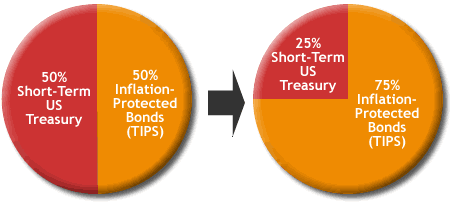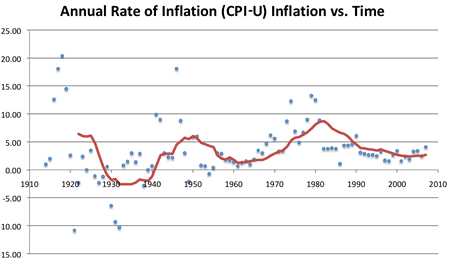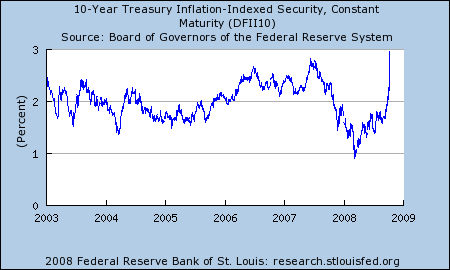This past week, I made some minor tweaks to my investments. No, I didn’t go all cash! Previously, I had set the bond portion of my portfolio to be 50% short-term Treasury bonds and 50% Treasury inflation-protected bonds (TIPS). I use the mutual funds VFISX and VIPSX. However, this week I shifted my allocation to be 25% short-term Treasury bonds and 75% Treasury inflation-protected bonds (TIPS).

Comparing Yields to Find Expected Inflation
You can compare the nominal yield of the Treasury bonds and the real yield of TIPS and find the implicit expected inflation. For example, if a 20-year Treasury bond yields 5%, and TIPS yield 2% real, then the expected inflation is the difference, or 3%. (If inflation is 3%, then the nominal yield of TIPS becomes 2% + 3% = 5%.)
This week, the expected inflation over the next 10 years has been hovering around 1%, some of the lowest in a long time. On Monday, the 10-year Treasury yield was 4.08% and the TIPS real yield was 3.05% (source: US Treasury), for an expected inflation of 1.03%. As of Friday, the gap was 1.02%. For the 20-year bonds, the gap predicted inflation of a about 1.6-1.8%. If the actual inflation rate turns out to be greater than these values, then holding TIPS will result in a higher yield over time.
Here is a chart of annual CPI-U changes over time (source: BLS.gov). The red line is the 10-year moving average:

Yes, there are deflation worries in the near future, but you can see the only decade that inflation has averaged below 1% was during the Great Depression. Not only that, but our currency was still on the gold standard then.
Currently High Real Yields
As mentioned earlier, the current real yields offered by TIPS of around 3% are also the highest in many years:

Since real yields are rising, the value of existing TIPS have actually dropped. So I’m buying low. 🙂 If real yields rise any higher, I’d buy even more.
Making The Change
There are many things to consider out out there, like global demand and the infamous $700 Billion bailout package (where do you think this money comes from?), but I only see more spending and borrowing down the road. With the printing presses available to go full blast, and lots of future promises made, I just can’t see inflation being this low for a decade.
Combine this with the fact that TIPS have a historically high real yield, it would seem like the market is overreacting. Although I usually don’t make such changes, I decided to go for it. So far, I have chosen not to go with 100% TIPS because I wanted to maintain some of the benefits of short-term treasuries, like lower volatility and low correlations with other assets. It’s kind of tough though, as the yields are horribly low right now due to the flight-to-quality.
I haven’t increased the target amount of total bonds in my portfolio, although due to the current drift and limitations due to juggling separate accounts, they are now 18% instead of 15%. I still believe in stocks as well due to their low valuations, and have also made equities purchases this week to re-balance that side of my portfolio. I am expecting to invest another $10,000+ before the year ends.
 The Best Credit Card Bonus Offers – 2025
The Best Credit Card Bonus Offers – 2025 Big List of Free Stocks from Brokerage Apps
Big List of Free Stocks from Brokerage Apps Best Interest Rates on Cash - 2025
Best Interest Rates on Cash - 2025 Free Credit Scores x 3 + Free Credit Monitoring
Free Credit Scores x 3 + Free Credit Monitoring Best No Fee 0% APR Balance Transfer Offers
Best No Fee 0% APR Balance Transfer Offers Little-Known Cellular Data Plans That Can Save Big Money
Little-Known Cellular Data Plans That Can Save Big Money How To Haggle Your Cable or Direct TV Bill
How To Haggle Your Cable or Direct TV Bill Big List of Free Consumer Data Reports (Credit, Rent, Work)
Big List of Free Consumer Data Reports (Credit, Rent, Work)
Jonathan – how are you accounting for TIPS tax inefficiency (I thought they were not as tax friendly as Treasuries). Are you buying these index funds in a tax-deferred account?
What equity purchases have you made?
Jonathan – I too have loaded up on VIPSX. I also have a bunch of I-Bond but dialed back purchases when they dropped the fixed rate to 0%. I like the tax efficiency of the I-Bonds. I see that you blogged about them. How do they fit in with your overall portfolio strategy?
Jonathan, sorry if I missed it, what is your reasoning for investing in VIPSX and not straight TIPS? I have VIPSX in my IRA.
I’m assuming you bought VIPSX and not individual TIPS issues?
in this particular environment, I would argue buying individual TIPS issues is a better idea, if you can, simply because you can lock in the 3% real yield for a longer maturity. VIPSX has a 7 or 9 year rolling maturity, a time period over which deflationary forces are more likely to have some impact (though I still think it is unlikely). The longer the duration, the less likely low aggregate inflation over that time period is, and the more attractive the high real yield becomes. I didn’t move from my 50% intermediate treasuries and 50% TIPS (of my total 20% bond allocation), largely because I don’t have easy access to moving from one fund to another in my taxable accounts without at least a day out of the markets, commissions, and potentially undesirable fund choices.
I did however sell 2/3 of my TIP ETF and move it into the 2026 issue at a 3.0% real yield to capture what I consider to have been a free lunch. I wold actually have like to mov out of some of my intermediate treasuries and into this same issue, but already yields have dropped on the 2026, and timing this volatile market by selling out of my Spartan Intermediate term US Treasuries to get into the TIPs issue could have left me out in the cold. Too bad, because I really would have like to do so…
Great Post Jonathan. These posts are really helping us navigate our own financial futures during these tough times.
With regards to the $700 Billion bailout package, at least we now know where 10% of the money is going (check out the below link):
http://www.guardian.co.uk/business/2008/oct/17/executivesalaries-banking
ethan – Yes, buying only in tax-deferred accounts.
Tax Efficiency
Previous implementation
john – Mainly to rebalance – Broad US, Developed International, and Emerging markets. Details to come once I invest the rest.
I-Bonds were written about yesterday – I’d rather buy TIPS for long-term use. If I only had room in taxable, I might consider I-Bonds, but not at 0% real!
Ross – Individual TIPS save you a bit in expenses, and let you control maturity. These days you’d primarily want to make it longer since you can get 3% for 20-years. I think think it’s a good idea if you really think this is as good as it gets.
But you also have to deal with reinvesting the interest payments yourself in a tax-deferred account, which can leave you with little bits of money that you can’t do anything with.
If I had more cash to deploy, and wasn’t mostly in stocks at this age, I’d go for it. But my amounts are still pretty low, and you have to buy in $1,000 increments. With a mutual fund, you can buy exactly $4,323 and reinvest the dividends automatically.
Yep, I with Ethan, TIPS only makes sense outside of a tax ding.
John,
what is the deal with tax efficiency w.r.t VIPSX. So did you open a IRA for this, since I am in the same boat as you & dont qualify for a ROTH
Cheers
I am buying these in my existing IRA, and perhaps later my solo 401k. Both TIPS and VIPSX give off gains for both the real coupon and principal inflation adjustment. Basically, any capital gains are taxed at ordinary income rates (not the lower 15% qualified dividend rate). This makes them much less desirable in taxable accounts vs. things like low-turnover stock index funds.
They don’t have to be in a Roth IRA, a regular IRA, rollover IRA, or flexible 401k will do. Even a non-deductible IRA will work.
How does VIPSX relate to Treasure Bonds VUSTX ?? According to Vanguard the yield in the short term and possibly on the long term is VUSTX is that dependent on the inflation rate? Is investing in Treasury Bonds a bad idea it is fairly consistent over the life as a portion of my IRA’s
Invest in different types of financial securities can diversify the risks associated with it, buying bonds is an alternative choice.
Jonathan,
Per my asset allocation, I am supposed to buy $10,000 of TIPS in an IRA. But due to the contribution limits, I can buy only $5000 this year. Do you believe it makes sense to buy $5000 of GLD in a taxable account (to account for the lower TIPS purchased)?